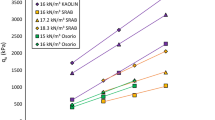Abstract
The hydraulic conductivity of soilcrete is the key parameter to evaluate the effectiveness of seepage cutoff applications. However, the hydraulic conductivity is difficult to determine and remains inconsistent. This paper attempts to determine the hydraulic conductivity of soilcrete specimens made in laboratory using the designed and manufactured permeameters. The several soilcrete specimens were made by mixing the soft clay and medium clay samples taken in the Mekong delta with various cement contents of 200, 250, 300, and 350 kg/m3, respectively. The falling head and constant tail method was employed to obtain the hydraulic conductivity of soilcrete specimens in the both designed rigid (ASTM D5856) and flexible wall (ASTM D5084) permeameters. The results indicate that the hydraulic conductivity of the soilcrete is lower 100 times than that of the unmixed soft clay. The hydraulic conductivity of the soilcrete was around 10–9 m/s or lower. The permeability decreased with increasing in curing time and in cement contents. The designed and manufactured flexible wall permeameter is appropriate to determine the hydraulic conductivity of soilcrete.










Similar content being viewed by others
Availability of data and materials
All data generated or analyzed during this study are included in this published article.
References
American Society for Testing and Materials (1997) Standard test for measurement of hydraulic conductivity of saturated porous material using a flexible wall permeameter. ASTM D5084, p 8
American Society for Testing and Materials (2002) Standard test for measurement of hydraulic conductivity of saturated porous material using a rigid-wall, compaction-mold permeameter. ASTM D 5856, p 8
Abbey SJ, Ngambi S, Olubanwo AO, Tetteh FK (2018) Strength and hydraulic conductivity of cement and by–product cementitious materials improved soil. Int J Appl Eng Res 13(10):8684–8694
Bellezza I, Fratalocchi E (2006) Effectiveness of cement on hydraulic conductivity of compacted soil–cement mixtures. Ground Improv J 10(2):77–90
Boynton SS, Daniel DE (1985) Hydraulic conductivity tests on compacted clay. J Geotech Eng 111(4):465–478
Chew SH, Kamruzzaman AHM, Lee FH (2004) Physicochemical and engineering behaviour of cement treated clays. J Geotech Geoenviron Eng 130(7):696–706
Deng Y, Yue X, Liu S, Chen Y, Zhang D (2015) Hydraulic conductivity of cement stabilized marine clay with metakaolin and its correlation with pore size distribution. Eng Geol J 193:146–152
EuroSoilStab (2002) Development of design and construction methods to stabilize soft organic soils. Design guide soft soil stabilisation. CT97–0351 Project No. BE 96–3177, p 94
Govindasamy P, Taha MR (2016) Hydraulic conductivity of residual soil-cement mix. IOP Conference Series: Materials Science and Engineering 136:012031
Helson O, Eslami J, Beaucour A, Noumowe A, Gotteland P (2018) Hydro-mechanical behaviour of soilcrete through a parametric laboratory study. Constr Build Mater 166:657–667
Ikhlef NS, Ghembaza MS, Dahouch M (2015) Effect of treatment with cement on the mechanical characteristics of silt from Telagh region of Sidi Belabes, Algeria. J Geotech Geol Eng 33(4):1067–1079
Janz M, Johansson SE (2002) The function of different binding agents in deep stabilization. Swedish Geotechnical Institute, SE-581 93 Linkoping, pp 1–47
Kitazume M, Terashi M (2013) The deep mixing method. CRC Press, Balkema, London, p 405
Mengue E, Mroueh H, Lancelot L, Eko RM (2017) Physicochemical and consolidation properties of compacted lateritic soil treated with cement. Soils and Found J 57:60–79
Ministry of Science and Technology (2012) Stabilization of soft soil – the soil cement column method. TCVN 9403, Vietnam, p 42, (in Vietnamese)
Porbaha A (2000) State of the art in deep mixing technology: part III: geomaterial characterization. Ground Improv 3:91–110
Tran TD, Cui YJ, Tang AM, Audiguier M, Cojean R (2014) Effects of lime treatment on the microstructure and hydraulic conductivity of Héricourt clay. J Rock Mech Geotech Eng 6(5):399–404
Tran-Nguyen HH, Quach HC (2018) Jet Grouting mitigating settlement of bridge approaching embankments of Tam Bang and Vam Dinh bridges. In: Proc. of the 4th Congrèss Intl de Géotechnique-Ouvrages-Structures, HCM, Vietnam, pp 736-745
Tran-Nguyen HH, Le PL, Le KB, Ly TMH (2018) Field trials on the soil cement technology to reinforce earth levees in the Mekong delta, Vietnam. Asian Eng J 8(1):14–26
Tran-Nguyen HH, Kitazume M, Tanaka H, Le KB, Le PL, et al. (2015) Laboratory investigation of soilcrete created from Mekong delta’s soils mixed with cement. In: Proc. of the deep mixing 2015 conference, San Francisco, USA, pp 725–734, 2–5 June
Tran-Nguyen HH, Le TT, Ly HT (2014) A field trial study on jet grouting to improve the subsoil in Ho Chi Minh City, Vietnam. J Teknol 69(3):23–29
Yu Y, Pu J, Ugai K, Hara T (1999) A study on permeability of soil-cement mixture. Soils and Found J 39(5):145–149
Acknowledgements
This study was funded by Vietnam National University – Ho Chi Minh City (VNU-HCM) under the project No. B2018-20-04 and directly supported by Ho Chi Minh City University of Technology (HCMUT-VNU-HCM).
Funding
No. B2018-20–04 by Vietnam National University in Ho Chi Minh City for Asc. Prof. Hoang-Hung Tran-Nguyen.
Author information
Authors and Affiliations
Contributions
(1) Associate professor H-HT-N: Write the first draft and revision of the manuscript: Supervise to conduct this study. Interpret data: Take full responsibility to revise and modify this article until finished. (2) (Ms.) BTL: Conduct tests partially: Analyze data partially: Revise the manuscript. (3) (Mr.) KDTN: Conduct tests partially: Analyze data partially: Write a report in Vietnamese.
Corresponding author
Ethics declarations
Conflict of interest
The authors declare they have no financial interests.
Additional information
Publisher's Note
Springer Nature remains neutral with regard to jurisdictional claims in published maps and institutional affiliations.
Rights and permissions
Springer Nature or its licensor (e.g. a society or other partner) holds exclusive rights to this article under a publishing agreement with the author(s) or other rightsholder(s); author self-archiving of the accepted manuscript version of this article is solely governed by the terms of such publishing agreement and applicable law.
About this article
Cite this article
Tran-Nguyen, HH., Luong, B.T. & Nguyen, K.D.T. Investigation of the Hydraulic Conductivity of Soilcrete Specimens Made by Soft Clays and Medium Clays Mixed with Cement. Geotech Geol Eng 41, 1073–1082 (2023). https://doi.org/10.1007/s10706-022-02323-2
Received:
Accepted:
Published:
Issue Date:
DOI: https://doi.org/10.1007/s10706-022-02323-2




